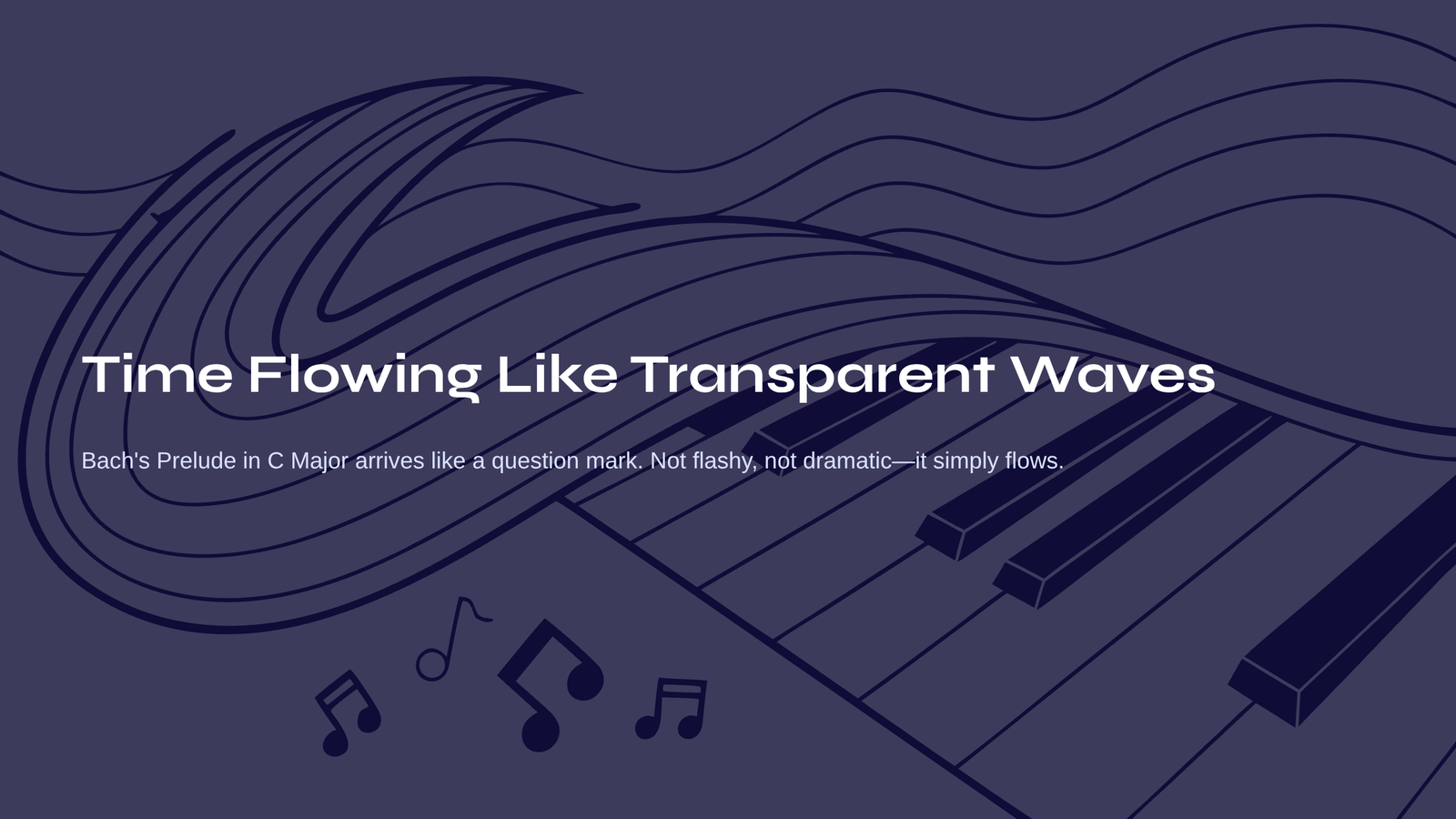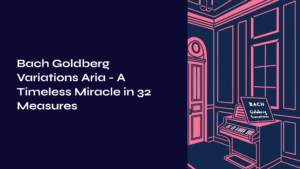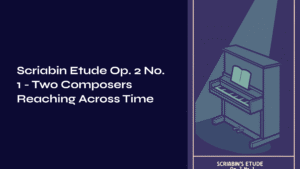Table of Contents
Every Beginning Arrives Like a Question Mark
When I first heard this piece, I was waiting for something to happen. I expected a melody to leap out, a dramatic development to unfold. But Bach’s Prelude in C Major quietly sidesteps such expectations. What it offers instead is a continuously repeating arpeggio, a flow of notes that washes over you like transparent waves lapping at your ankles.
This piece isn’t flashy. It isn’t dramatic. It simply flows. And yet, strangely, within that flow I find myself standing still. Not waiting for something, but listening to this very moment. Bach’s Prelude in C Major BWV 846 begins this way—seemingly about nothing, yet containing everything.
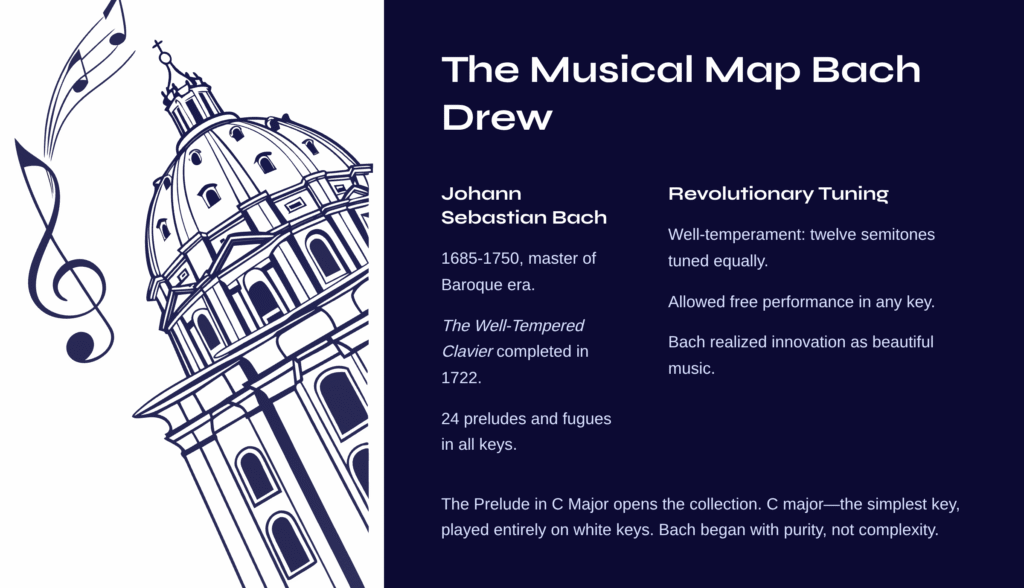
The Musical Map Bach Drew: The Well-Tempered Clavier
Johann Sebastian Bach (1685-1750) was a master of the Baroque era. His The Well-Tempered Clavier, Book I was completed in 1722 and contains preludes and fugues written in 24 different keys. This work goes beyond simply beautiful music—it was also a textbook that experimented with and demonstrated the revolutionary “well-tempered” tuning system of its time.
Well-temperament is a system where all twelve semitones are tuned at equal intervals, allowing free performance in any key. What seems obvious now was the key to a new world in Bach’s time. Bach didn’t leave this innovation as mere theory—he realized it as beautiful music.
The Prelude in C Major is the first piece. C major, the simplest and most basic key. This piece, played entirely on white keys without a single black key, shows that Bach wanted to begin not with complexity but with purity. True to its name as a “prelude,” this piece is both a preparation for the fugue that follows and a complete world unto itself.
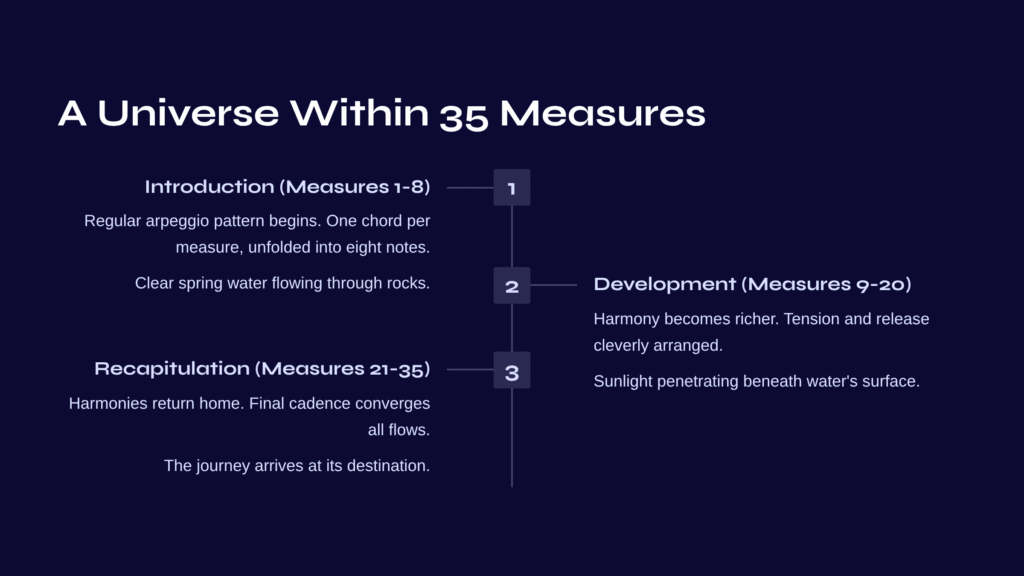
A Universe Within 35 Measures: The Structure and Flow of the Prelude in C Major
Bach’s Prelude in C Major consists of just 35 measures. You might think that’s short, but within it lies astonishing architectural beauty. The piece can be divided into three main sections.
Introduction (Measures 1-8): A Transparent Beginning
From the first measure, both hands trace a regular arpeggio pattern. One chord per measure, that chord unfolded into eight notes. Beginning with the tonic chord of C major, it provides stability before naturally moving to other chords. Listening to this section feels like clear spring water flowing through gaps in rocks. No obstacles, just flowing.
Development (Measures 9-20): Expanding Colors
The pattern from the introduction continues, but the harmony becomes richer. Bach cleverly arranges tension and release within the same form. In some measures, the chords darken slightly to create tension; in the next, they brighten again to provide relief. As this process repeats, the music gradually leads us to deeper places. Close your eyes and listen, and you can picture sunlight penetrating beneath the water’s surface.
Recapitulation (Measures 21-35): Return and Resolution
The harmonies that ventured far in the development section return home. The pattern from the introduction reappears, restoring stability, and the final measure concludes with a grand cadence. This cadence isn’t simply an ending. It’s the moment when all the flows converge into a single point, and in that moment we finally realize, “Ah, this piece was a journey to arrive here.”
What runs through the entire piece is a continuous stream of eighth notes. These notes flow without stopping once throughout the 35 measures, moving as regularly as a clock’s second hand yet with vitality. Each finger pressing the keys creates a small universe.
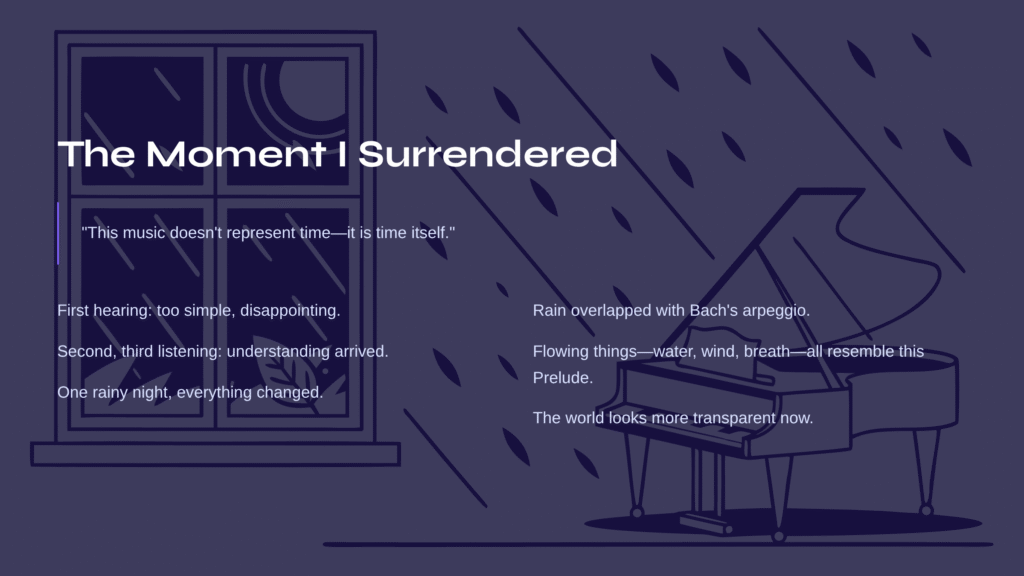
The Moment I Surrendered to Bach’s Waves
When I first heard this piece, I was honestly a little disappointed. It seemed too simple. The same pattern repeating, no distinct melody, no dramatic changes. But as I listened a second time, a third time, I understood. This piece isn’t music that “tries to show something.” It’s music that simply “is.”
One night, rain fell outside the window. I turned off the lights and played this piece. The sound of rain overlapped with Bach’s arpeggio. That’s when I felt it. This music doesn’t represent time—it is time itself. Flowing things—water, wind, rain, breath—all of them resemble Bach’s Prelude.
Bach’s Prelude taught me “how to listen.” Not waiting for some special moment, but paying attention to each sound flowing right now. How to feel the subtle color changes in each chord, the small tremors created when notes meet, and the perfect balance that all of this creates together.
After listening to this piece, the world looks a little more transparent. Bach proves in 35 measures that complex things are actually just combinations of simple elements, and that true beauty lies in that simplicity.
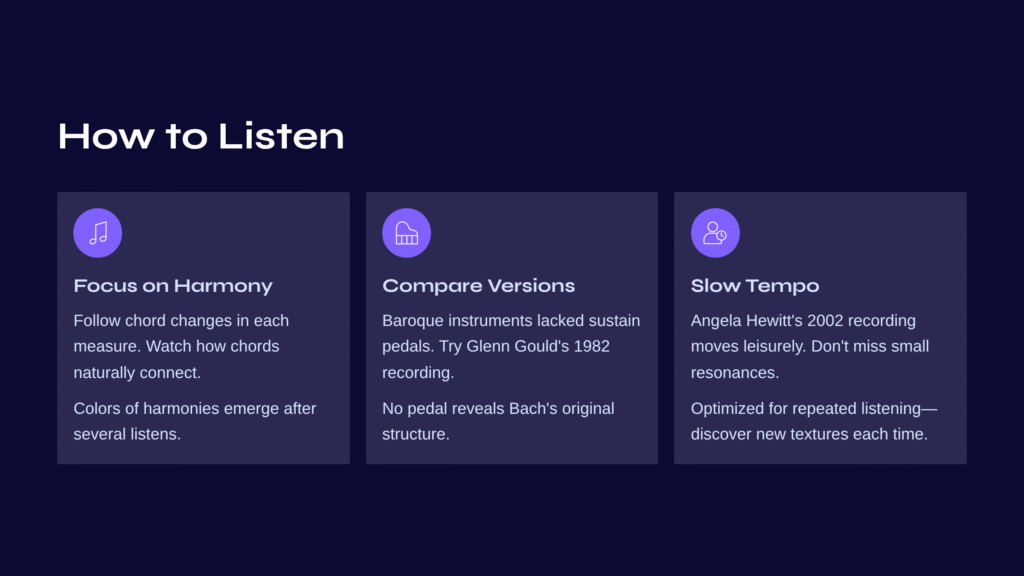
How to Listen to Bach’s Prelude in C Major
1. Focus on Harmonic Changes
Since the melody doesn’t stand out in this piece, following the chord changes in each measure is key. Try listening with awareness of what chord each measure unfolds and how that chord naturally connects to the next. It may feel difficult at first, but after listening several times, you’ll begin to see the colors of the harmonies.
2. Compare Versions With and Without Pedal
The keyboard instruments of the Baroque era (harpsichord, clavichord) didn’t have the sustain pedal of modern pianos. So if you want to hear this piece in its original form, look for performances that minimize or completely avoid pedal use. Glenn Gould’s 1982 recording or András Schiff’s interpretation are good examples. Performances without pedal make the beginning and end of each note clearer, allowing you to hear the structure Bach designed more distinctly.
3. Slow Tempo, Repeated Listening
Versions performed at faster tempos are wonderful too, but for first-time listening, I recommend a slower tempo. A leisurely tempo like Angela Hewitt’s 2002 recording ensures you don’t miss even the small resonances each note creates. And this piece is optimized for repeated listening. It’s not music you understand in one hearing, but music where you discover new textures with each listen.
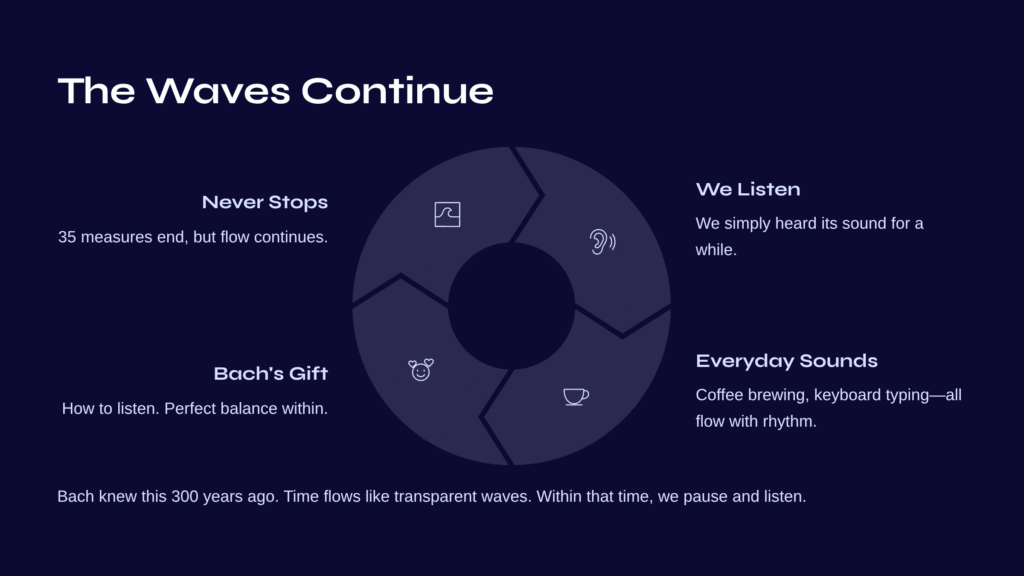
The Waves Continue
Bach’s Prelude in C Major is neither a beginning nor an end. It merely captures one moment in a flow. After the 35 measures end, we know that the flow never actually stopped. Somewhere, that arpeggio is still flowing, and we simply listened to its sound for a while.
After hearing this piece, I began to hear everyday sounds differently. The sound of brewing coffee, typing on a keyboard, cars passing by. Everything flows with its own rhythm and pattern. Bach knew this 300 years ago and inscribed that truth on the keyboard.
Time flowing like transparent waves. Within that time, we pause for breath, open our ears, and listen to the sounds of the world. That’s the gift Bach’s Prelude gives us. How to listen. And the perfect balance discovered within.
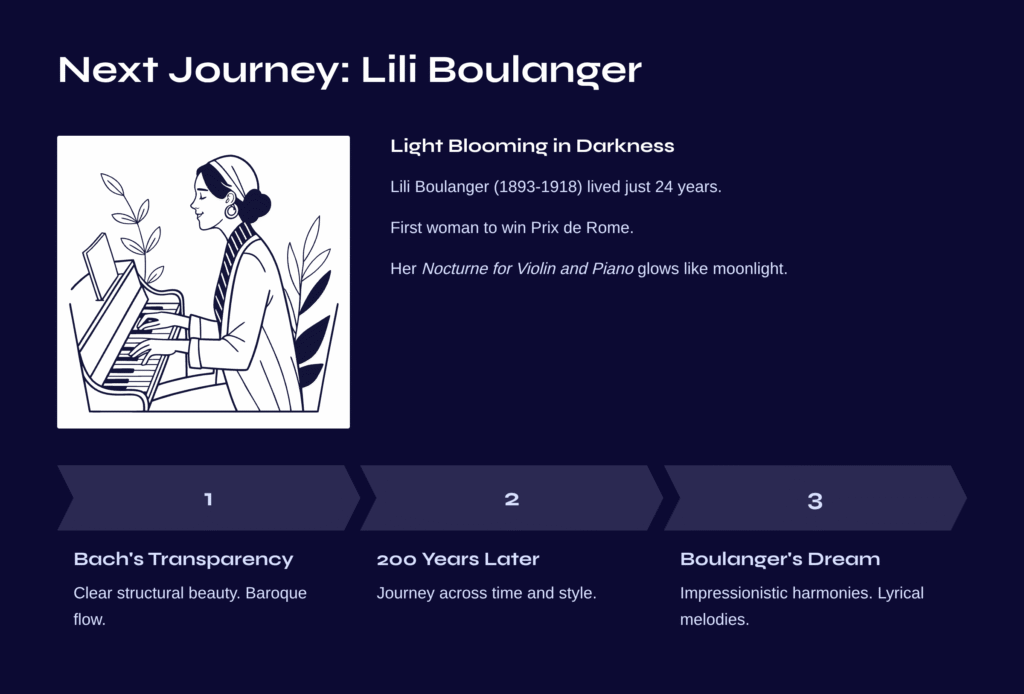
Next Journey: Light Blooming in Darkness, Lili Boulanger’s Nocturne
To you who have flowed along Bach’s transparent waves, I now want to introduce music from an entirely different era. The Nocturne for Violin and Piano left by early 20th-century French composer Lili Boulanger (1893-1918).
Lili Boulanger lived a short life of 24 years but filled it with remarkable musical depth. She was the first woman composer to win the Prix de Rome, and along with her sister Nadia Boulanger, left a significant mark on 20th-century French music. However, her music, created while battling illness throughout her life, contains a unique melancholy and transcendent beauty.
The Nocturne is like a conversation between violin and piano. If Bach’s Prelude was a transparent flow, Boulanger’s Nocturne is like moonlight glowing softly in darkness. The violin sometimes whispers, sometimes sobs, while the piano gently supports from behind. Impressionistic harmonies and lyrical melodies interweave, touching the deepest parts of the listener’s heart.
The path from Bach to Boulanger is a journey leaping across 200 years. From the clear structural beauty of the Baroque to the dreamlike sensibility of the early 20th century. Yet both pieces of music ask the same thing of us: to listen quietly and feel the sincerity contained in the sound. Boulanger’s Nocturne will guide you to yet another world of sensibility while preserving the transparency Bach left behind.
